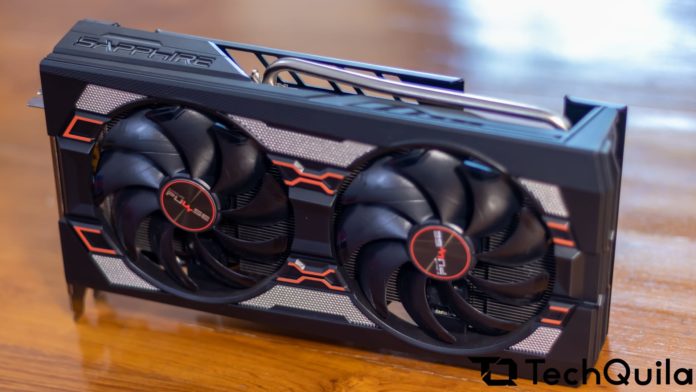
Earlier this year AMD announced the arrival of the Radeon RX 5600 XT, which was target specifically towards gamers playing at 1080p resolution. The new card doesn’t have any reference design (or founder’s edition, as NVIDIA calls them), so we’ll be taking a look at the Sapphire Pulse RX 5600 XT variant.
AMD claims it is the best card you can buy right now for 1080p gaming. At this budget, there are a lot of other cards from NVIDIA and even AMD’s older catalog that can be purchased. Gaming at 1080p has become relatively more popular now that it’s more affordable, with cards like the Geforce GTX 1060 which was previously the top choice for that resolution. The 5600 XT is really meant to compete with that card and, hopefully, take the top spot.
Note: While the card is priced at the same segment that the GTX 1060 was back when it launched, it’s actually closer to the RTX 2060’s current MSRP. This was due to NVIDIA dropping down the price of the RTX 2060 to compete with AMD’s card when it launched. Needless to say, this change was met with a lot of confused responses from both the company’s fans.

Sapphire Pulse RX 5600 XT Specs
| Sapphire Pulse RX 5600 XT | |
| Compute Units | 36 |
| Cores/Stream Processors | 2304 |
| Boost Frequency | 1750 Mhz |
| Game Frequency | 1615 Mhz |
| Memory | 6 GB |
| TDP | 150 W |
| Price | ~ Rs. 30,000 |
The RX 5600 XT comes with 36 compute units with a boost clock of 1560 MHz. The typical ‘game frequency’ will be 1375 Mhz, and the card’s TDP is rated at 150W.
Coming to the ports, this particular 5600 XT has 3 Display Ports and 1 HDMI 2.0 port. That’s quite a decent amount considering the target demographic. It uses an 8-pin (6+2) power connector. Our particular Sapphire Pulse card has an OEM-set clock of 1620 MHz.
With 6 GB of VRAM and 1080p target, this card aims to replace the NVIDIA GTX 1060, which is one of the most popular GPUs in the market. The GTX 1060 had 2 variants with 3 GB and 6 GB VRAM. As is clear now, the 5600 XT is pretty much meant to top that $300 segment of budget 1080p cards. We’ve seen previously that at 1080p, most games won’t use any more than 4 GB today at their highest settings. With that in mind, it’s nice to see AMD offering cards with more memory support which makes them a little more future proof.

Test Rig and Benchmarking Methodology
We used the following system for benchmarking the card:
- CPU – Ryzen 7 3700X
- RAM – 2×8 GB G.Skill Trident Z RGB at 3000 MHz
- Motherboard – ASUS Prime X570-P
- Power Supply – Corsair CX 550W
Seeing as how this card is targeted towards budget gamers, we only tested games at 1080p resolution, using a bunch of older as well as newer games using DirectX 12. Another thing to note is that we used the default settings for the card, without touching any additional overclocking setting or anything else. This is what the most standard experience is going to be for the majority of gamers.
RX 5600 XT Gaming Performance Benchmarks at 1080p

As you can see from the benchmarks above, the RX 5600 XT can touch, and in some cases even break, the 60 fps target in most AAA games. Keep in mind that we tested all of these games at their highest settings, so that is pretty impressive.
Another thing to note is that the image quality that you get today when playing at 1080p can get considerably sharper than when the GTX 1060 released. Yes, that whole sentence reads like an idiot wrote it, but hear me out. The proprietary image sharpening features that both AMD and NVIDIA provide are pretty impressive. On the AMD side, you get features like Radeon Image Sharpening, Radeon Anti-Lag, Radeon Boost, and not to forget – Freesync. All of these features make gaming at 1080p a much better experience than what it was a few years ago.
As for pure numbers, the RX 5600 XT is roughly 50% faster than the GTX 1060, as backed by these benchmarks by TechSpot. When compared to the cheaper 1650 Super, we saw an increase of roughly 30% performance with in-game benchmarks, which falls in line perfectly with the difference in cost.
Moving on to other benchmarks:

- 3D Mark Timespy – 7659
- Furmark GPU Stress Test – 6692 (Average 112fps)
RX 5600 XT Overclocking Gains and Verdict
As with our Radeon RX 5500 XT unit, the RX 5600 XT can clock up to 1860 MHz when overclocked using Radeon Software. We suggest using the card at its default settings, or the default ‘Overclocked mode’ in Radeon software. You can get back to overclocking later on when more demanding titles come out.
Overall, the RX 5600 XT is a great choice for gamers who want to upgrade from the aging GTX 1060. AMD has cleverly put the card at that exact price range to entice modest budget PC builders. The card pushes above 60 FPS in most instances at 1080p, and the continued driver support from AMD should help the card survive the onslaught of more demanding games over the next few years.




